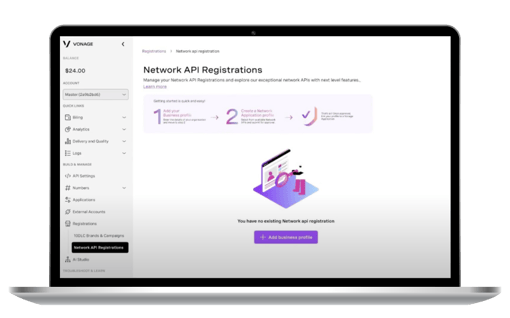SIM Swap
Detect recent SIM changes to block fraudulent logins, password resets, and payouts before funds move. Powered by live mobile network data, SIM Swap helps you prevent social-engineering attacks and meet PSD2 and FCA guidance — without adding friction to the customer experience.
Enhanced Security
Vonage SIM Swap enhances fraud protection with live mobile network intelligence that instantly identifies recent SIM changes, helping prevent account takeovers without adding user friction.Customer Trust
Differentiated fraud prevention helps build customer loyalty, lowers the risk of reputational damage from data breaches and attacks, and offers a better customer experience.Financial Stability
Financial losses due to fraud and unauthorized transactions can add up quickly. SIM Swap API mitigates fraud, which helps avoid legal fees and recovery costs.Regulatory Compliance
Vonage SIM Swap API complies with consumer data and privacy regulations like GDPR and HIPAA. It also aligns with security regulations like CI DSS, and CAMARA/GSMA standards.
How Vonage SIM Swap API Works in the Real World
From amplifying traditional 2FA to managing employee identity theft — Vonage SIM Swap API can create safer, better experiences. Here are just a few ways to use the API with your business:
Banking, fintech, and insurance: Add an extra verification layer to monitor SIM activity when a transaction is flagged as suspicious. Your app can configure alerts for frequent SIM activities to identify and proactively prevent fraud before it happens. Also, ensure that Transaction Authentication Number (TAN)-based transactions are authorized by the user and decreases the risk of unauthorized access and fraud attempts.
Social networks: Integrate Vonage SIM Swap API into your app to protect against account hijacking, data breaches, and identity theft. Use it as often as necessary to monitor and detect suspicious SIM-swapping activities associated with user accounts.
Corporate protection: Safeguard against hijacking of company personnel’s phone numbers or other sensitive information, like internal corporate communications and documents. This proactive measure helps protect against potential business losses and ensures the integrity of your organization's confidential data.
Ecommerce and retail: Enhance the security of online payment transactions to prevent fraud and confirm the legitimacy of payments, ensuring a safe shopping space for customers.

Get Access to SIM Swap Through the Vonage Network Registry.
The Vonage Network Registry reduces network complexities such as provisioning and configuration, while facilitating seamless communication between diverse networks and devices. This helps developers and businesses.
Network Registry features a Sandbox that enables developers to begin building and testing immediately, eliminating the need to wait for network approvals.
It also provides convenient, centralized access to network capabilities, using Vonage Network APIs to build better and more secure apps.
What Goes Well with SIM Swap? Silent Authentication
Authenticate users instantly through the mobile network without any OTPs to send, copy, or intercept. Enjoy two-factor authentication that’s 2x faster, more secure against man-in-the-middle attacks, and built to streamline customer experience and drive conversions.
Network-Powered Solution
Vonage SIM Swap leverages live mobile network intelligence to deliver advanced account takeover protection without adding user friction.
FAQs About SIM Swap
A SIM swap, a type of fraud in which scammers take control of your phone number by transferring it to a SIM card they own, happens when your mobile carrier is tricked into believing it is you.
A SIM swap works by a scammer impersonating the victim and convincing their mobile carrier to transfer the victim's phone number to a SIM card controlled by the scammer. Through phishing or data breaches, the fraudster typically gathers personal information, such as the victim’s name, address, and phone number. Once the scammer has enough information, they contact the mobile carrier, pretending to be the victim, and request the SIM swap.
Once the transfer is successful, the scammer can access the victim’s phone number and receive calls and text messages, including critical information like two-factor authentication codes sent by banks or other services. This enables the fraudster to reset passwords, access accounts, and commit crimes.
Yes, SIM swaps are illegal. Fraudsters use SIM swapping to commit identity theft and financial fraud. Carriers and law enforcement agencies take these crimes seriously and work to prevent and prosecute them.
If you believe you've been SIM swapped, immediately contact your mobile carrier to regain control of your account. Also, change passwords for important accounts, enable multi-factor authentication, and monitor your accounts for any unauthorized activity.
To prevent SIM swap fraud, secure your mobile carrier account with a strong PIN or password only you know. Many carriers also offer additional security features, such as account lock options, which prevent unauthorized changes to your account.
Additionally, avoid sharing personal information online or with untrusted sources, as scammers often use this data to impersonate you. Enable two-factor authentication (2FA) on your accounts using an app instead of SMS, which is more secure. Stay alert for signs of fraud, like unexpected loss of service, and contact your carrier immediately if you suspect a SIM swap.
A SIM swap is a fraudulent act where a scammer transfers your phone number to a new SIM card they control. This allows them to access your accounts and intercept calls and texts, including two-factor authentication codes.
Porting, on the other hand, is a legitimate process where you transfer your phone number from one carrier to another, typically when switching service providers. While porting requires verification steps to ensure the request is genuine, scammers can exploit this process if they obtain enough of your data.
A SIM replacement differs from a SIM swap as it is a legitimate process where a mobile carrier issues a new SIM card to a customer, typically when the original SIM is lost, damaged, or needs upgrading. The phone number and account remain the same, and the customer requests the replacement. Unlike a SIM swap, a SIM replacement is done with the customer's consent.

